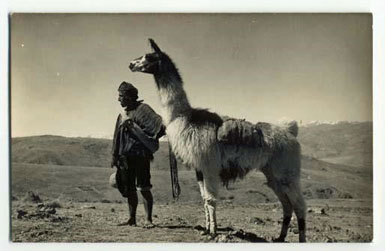What Is A Ccara Llama?

What Is a Ccara Llama?
Al Ellis
Highline Trail Llamas
Webmaster Note: originally published in the Spring 2015 RMLA Journal
The old adage “A picture is worth a thousand words” certainly holds true here. Not only does this photo of a Ccara llama and “his” llamero captured by Martin Chambi from Cusco, Peru, circa 1940 provide a perfect visual description of a Ccara Llama, it also encapsulates the mission statement of the North American Ccara Association (NACA): To seek out, preserve, perpetuate and promote the best specimens of the working llama-the Ccara.
The label “Ccara” is one of the native South American words or versions of spelling that was used to describe this animal, specifically llamas that were developed through selective breeding over the course of thousands of years for their ability to transport freight over long distances in rugged terrain and at high altitudes. Today many llama packers still utilize and cherish that same tough, high endurance athlete, strong physically and strong mentally, the Ccara Llama. Even if they all are not needed for their full capacity, they deserve to be admired and preserved.
Unfortunately over the last 30 years or so, their numbers have continued to dwindle and many of the best representatives of the breed have an alarming concentration of common ancestors. This presents a formidable challenge for those engaged in breeding Ccara Llamas who believe the gene pool should be expanded rather than continuing to shrink. A group of breeders concerned about the problem recognized the need for a registry to aid in the search for diverse genetics and banded together to form the North American Ccara Association (NACA). A full description and explanation of the characteristics of an animal eligible for entry into the registry can be found on the website listed below
Visit the NACA website for screening criteria and fee schedule, and further information regarding the itinerary. http://www.ccarallama.com. Contact: Nancy Hester, Latitude Llamas for screening registrations: 530 223-4569 or latitudellamas@aol.com
Like this article? Become a RMLA Member today!

